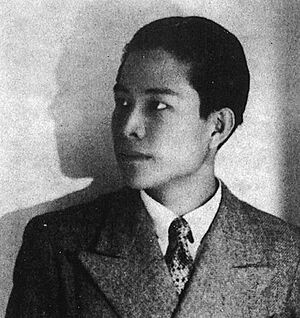Chiang Wen-yeh facts for kids
Quick facts for kids
Chiang Wen-yeh
|
|
|---|---|

Chiang in the 1930s
|
|
| Born | 11 July 1910 |
| Died | 24 October 1983 (aged 73) |
| Occupation | composer |
|
Notable work
|
Formosan Dance, Symphonia Lucis Universalis |
Chiang Wen-yeh (also known as Jiang Wenye) was a famous composer from Taiwan. He was born on June 11, 1910, in Taipei and passed away on October 24, 1983, in Beijing. He spent much of his life creating music in Japan and later in China.
In his music, Chiang Wen-yeh blended sounds from traditional Chinese, Taiwanese, and Japanese music. He also added modern musical ideas. For a while, his work was not well-known due to political changes. However, after his death, people in East Asia and the West began to appreciate his amazing music again.
Contents
Who Was Chiang Wen-yeh?
Early Life and Education
Chiang Wen-yeh was born in 1910 in Tamsui, Taiwan. At that time, Taiwan was under Japanese rule, so he was a Japanese citizen from birth. His family came from the Hakka people in Fujian, China.
In 1923, when he was 13, Chiang moved to Ueda, a small town in Japan. He went to secondary school there. Later, he studied electrical engineering at the Tokyo Engineering and Commerce Advanced School. At the same time, he also took evening classes at the Tokyo Music School. This showed his passion for music.
A Rising Star in Music
Chiang Wen-yeh first became known as a singer. In 1932, a choir leader discovered his talent. He then became a baritone singer for the Columbia Record Company. A few years later, he joined an opera company led by a famous Japanese opera singer, Yoshie Fujiwara.
Around this time, he also began to study how to compose music. He learned from important composers like Kosaku Yamada. Soon, he started winning awards for his own musical pieces. A big moment came in 1936. His orchestral work, Formosan Dance, received an honorable mention at the art competition during the 1936 Summer Olympics in Berlin. A composer named Alexander Tcherepnin noticed Chiang's skill. He helped publish Chiang's music in Europe, the United States, and China.
Life During Wartime
In 1938, during the Second Sino-Japanese War, Chiang Wen-yeh became a music professor. He taught at the Teacher's College in Beijing, which was then controlled by Japan. The Japanese government saw him as a way to connect with people in both nations.
For several years, he traveled between Beijing and Tokyo, where his family lived. During this time, he was one of the most popular composers in Japan. However, things changed after Japan surrendered in 1945. He lost his Japanese citizenship and became a citizen of China. His name soon disappeared from the Japanese music scene.
Challenges and Comeback
In China, Chiang's connections to Japan and his modern music style caused problems. He was seen as someone who didn't fit in with the government's ideas. To keep working, he had to change his music style to be more simple.
Events like the Anti-Rightist Movement in the 1950s and the Cultural Revolution in 1966 made things even harder for him. He became a target for political reasons. Some of his musical works, including three symphonies, seem to have been lost during these difficult times.
Finally, in 1978, his reputation was cleared. Sadly, by then, he was already ill. He passed away in Beijing in 1983.
His Music Lives On
After his name was cleared, Chiang Wen-yeh's music slowly began to be rediscovered. A new generation of people in Taiwan, China, Hong Kong, and Japan started to appreciate his work.
His life and music were even featured in a Japanese film. The 2003 movie Café Lumière, directed by Taiwanese filmmaker Hou Hsiao-hsien, tells the story of a young Japanese woman researching Chiang Wen-yeh. His music is part of the movie's soundtrack. His Japanese wife and daughter even appeared in the film as themselves.
Famous Compositions
Chiang Wen-yeh wrote many different kinds of music. Here are some of his well-known pieces:
- Formosa Dance Opus 1
- Five Sketches (1935)
- 4 Seiban Songs (1936)
- 3 Dances for Piano Opus 7
- 16 Bagatelles Opus 8
- Ceremony sontata for Flute and Piano Opus 17
- The Peking Myriorama Opus 22
- The Princess Shian-Fei Opus 34
- Piano Sonata No. 3 "Jiangnan Scenery" Opus 39
- 12 Poems on Folk Festivals Opus 53
- Piano Sonata No. 4 "Carnival Days" Opus 54
- Capriccio "The Fisherman's Boat Song" Opus 56
- Violin sontata "Hymns for Spring" Opus 59
- Symphonia Lucis Universalis (1943)
- The song of Ali Mountain
- A Confucian Ceremony
- Taiwan Dances
- "Hometown Festival" (Suite)
- "Guluo River" (Symphonic Poem)
- Symphonic Poem "Drowned in the Miluo River"
- Piano Trio "High Up in Taiwanese Mountain"

